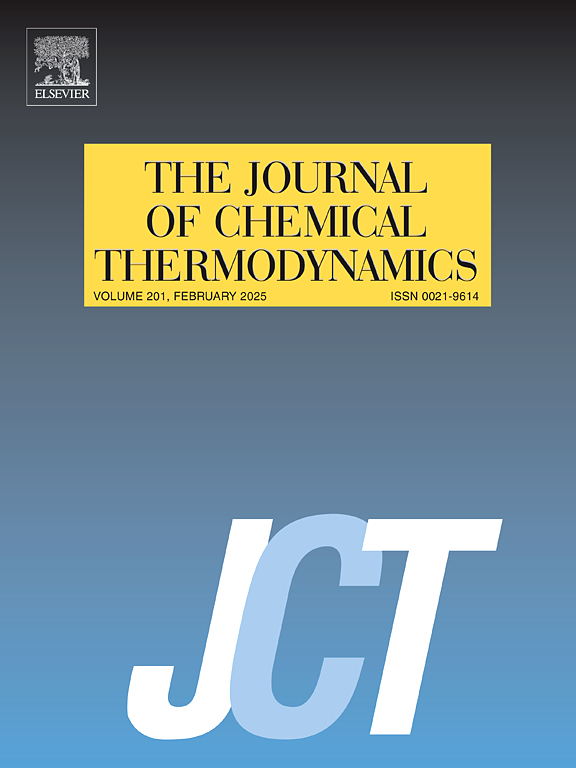New thermodynamic insights into pregabalin interactions with H+, Na+, Mg2+, Ca2+, Cu2+, Zn2+: Equilibrium constants, enthalpy changes and sequestering ability
IF 2.2
3区 工程技术
Q3 CHEMISTRY, PHYSICAL
引用次数: 0
Abstract
The thermodynamics of the interaction between (S)-(+)-3-aminomethyl-5-methylhexanoic acid (pregabalin) and protons was studied potentiometrically at different temperatures (288.15 ≤ T/K ≤ 310.15), ionic strengths (0.16 ≤ I/mol kg−1(H2O) ≤ 0.97, NaCl), (0.11 ≤ I/mol kg−1(H2O) ≤ 1.11, (C2H5)4NI), (0.10 ≤ I/mol kg−1(H2O) ≤ 1.03, NaClO4, only at T = 298.15 K). The protonation constants at infinite dilution and the corresponding enthalpy change values were determined, as well as their parameters for the dependence on the temperature and ionic strength. The results showed that the protonation reactions are exothermic, and that the entropic contribution is the driving force of the processes. Formation constants of pregabalin (L) with Zn2+, Cu2+, Ca2+, and Mg2+ were determined in NaCl(aq) at different ionic strength values, at 298.15 K. Different speciation models were proposed for the various metal/Pregabalin systems: ZnHL2+, ZnLOH0(aq), CuL+, CuL20(aq), CaL+, CaHL2+, and MgL+, depending on the different acid–base properties of the metals and the possible formation of sparingly soluble species. The modelling of the thermodynamic formation parameters respect to the temperature and ionic strength variation was carried out by using both the Specific Ion Interaction Theory (SIT) and an extended Debye-Hückel type equation. Being Pregabalin an emerging contaminant, it was interesting to investigate its distribution in presence of the investigated metal cations in aqueous solution simulating both biological fluid (urine) and natural water (seawater).

普瑞巴林与 H+、Na+、Mg2+、Ca2+、Cu2+、Zn2+ 相互作用的热力学新见解:平衡常数、焓变和螯合能力
在不同温度(288.15 ≤ T/K ≤ 310.15)、离子强度(0.16 ≤ I/mol kg-1(H2O) ≤ 0.97,NaCl)、(0.11 ≤ I/mol kg-1(H2O) ≤ 1.11,(C2H5)4NI)、(0.10 ≤ I/mol kg-1(H2O) ≤ 1.03,NaClO4,仅在 T = 298.15 K 时)。测定了无限稀释时的质子化常数和相应的焓变值,以及它们与温度和离子强度有关的参数。结果表明,质子化反应是放热反应,熵贡献是过程的驱动力。在 298.15 K 的 NaCl(aq)中,测定了不同离子强度值下普瑞巴林(L)与 Zn2+、Cu2+、Ca2+ 和 Mg2+ 的形成常数:ZnHL2+、ZnLOH0(aq)、CuL+、CuL20(aq)、CaL+、CaHL2+ 和 MgL+。通过使用特定离子相互作用理论(SIT)和扩展的 Debye-Hückel 型方程,对温度和离子强度变化的热力学形成参数进行了建模。由于普瑞巴林是一种新出现的污染物,因此有必要研究其在模拟生物液体(尿液)和天然水(海水)的水溶液中与所研究的金属阳离子存在时的分布情况。
本文章由计算机程序翻译,如有差异,请以英文原文为准。
求助全文
约1分钟内获得全文
求助全文
来源期刊

Journal of Chemical Thermodynamics
工程技术-热力学
CiteScore
5.60
自引率
15.40%
发文量
199
审稿时长
79 days
期刊介绍:
The Journal of Chemical Thermodynamics exists primarily for dissemination of significant new knowledge in experimental equilibrium thermodynamics and transport properties of chemical systems. The defining attributes of The Journal are the quality and relevance of the papers published.
The Journal publishes work relating to gases, liquids, solids, polymers, mixtures, solutions and interfaces. Studies on systems with variability, such as biological or bio-based materials, gas hydrates, among others, will also be considered provided these are well characterized and reproducible where possible. Experimental methods should be described in sufficient detail to allow critical assessment of the accuracy claimed.
Authors are encouraged to provide physical or chemical interpretations of the results. Articles can contain modelling sections providing representations of data or molecular insights into the properties or transformations studied. Theoretical papers on chemical thermodynamics using molecular theory or modelling are also considered.
The Journal welcomes review articles in the field of chemical thermodynamics but prospective authors should first consult one of the Editors concerning the suitability of the proposed review.
Contributions of a routine nature or reporting on uncharacterised materials are not accepted.
 求助内容:
求助内容: 应助结果提醒方式:
应助结果提醒方式:


